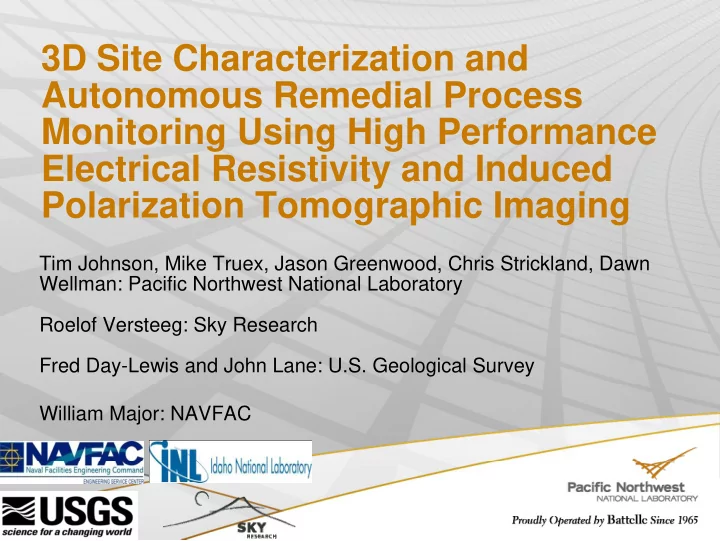

3D Site Characterization and Autonomous Remedial Process Monitoring Using High Performance Electrical Resistivity and Induced Polarization Tomographic Imaging Tim Johnson, Mike Truex, Jason Greenwood, Chris Strickland, Dawn Wellman: Pacific Northwest National Laboratory Roelof Versteeg: Sky Research Fred Day-Lewis and John Lane: U.S. Geological Survey William Major: NAVFAC 1
Acknowledgements ESTCP – Environmental Resotoration Optimized Enhanced Bioremediation Through Four- Dimensional Geophysical Monitoring and Dimensional Geophysical Monitoring and Autonomous Data Collection, Processing, and Analysis, ER-2001717 Andrews AFB Andrews AFB CH2MHILL Plateau Remediation Company 2
Outline Autonomous Electrical Resistivity Tomography (ERT) Autonomous Electrical Resistivity Tomography (ERT) characterization and monitoring systms. What and how we measure How we monitor spatial and temporal changes in electrical properties (time-lapse inversion) What does it mean in terms of properties we’re What does it mean in terms of properties we re interested in Examples Brandywine MD DRMO Superfund Bioremediation Monitoring Soil desiccation characterization and monitoring at the H Hanford BC Cribs f d BC C ib Concluding comments 3
ELECTRIC GEOPHYSICAL MONITORING COMPONENTS Automated & on demand results Server: Data QA/QC, Management Data Electrical geophysical Hydrologic Geochemical Time Time-lapse - lapse Amendment Maps Time-lapse Inversion 4
Field scale electrical geophysical measurements measurements Surface electrodes Measurement 1 Current Electrodes: 55,77 Potential Electrodes: 46,49 Borehole electrodes Current: 150 mA Voltage: 112 mV 112 mV Current Source 150 mA Current Sink 5
3D characterization and monitoring flowchart Baseline Characterization Inversion M 0 Starting Reference model ode model ode ∆ M 1 M 1 D 1 M 2 ∆ M 2 se data Electrical D 2 M 3 Resistivity / - - = = ∆ M 3 M 0 Time-laps Induced I d d D 3 Polarization . . . . . . Tomography . . . Inversion D N M M N ∆ M ∆ M 4 6
Pore-scale current conduction mechanisms Ionic Conduction is sensitive to: + Electric Field - Pore fluid conductivity Saturation Temperature Electronic Conduction is sensitive to: Mineral conductivity Temperature Interfacial Conduction is sensitive to: Interfacial electrochemistry T Temperature t Total Conductivity = ionic + electronic + interfacial 7
Brandywine MD DRMO Superfind Site Andrews AFB Site location Brandywine DRMO (green box) Brandywine - Primary groundwater contaminant is TCE Primary groundwater contaminant is TCE - Primary soil contaminants PCB - Plume has spread from Air force property to residential property - Contamination resides in upper 30 feet, sandy gravel, aquitard at 30 ft bgs 8
DRMO Enhanced Bioremediation Site location Site location Remedial Action - Amendment injections at ~1000 injection points points - Injection point spacing ~ 20 ft - Dem/Val effort monitored two of the injections at edge of March/April 2008 treatment area Dem/Val study area (injections B6 & B7) Brandywine DRMO (green box) 9
ERT/IP Monitoring Systems Details Injection Well Injection Well Sample Well Sample Well (3/10/08) • 8 Chem sample wells ERT/IP Well • 7 ERT/Chem wells • 7 ERT/Chem wells - ERT wells: 15 electrodes @ 2 feet spacing. 2 inch Sampling ports at 11,19 and 26 feet 26 feet Sample -Sampling wells: sampling Ports Electrodes ports at 11 and 19 feet. Well screen at bottom (26 feet) screen at bottom (26 feet) -45 total sampling ports -ERT data acquisition: repeat 3D survey with 35000 3D survey with 35000 measurements Groundwater Flow to West ~60 ft/year 10
Time-lapse ERT imaging results Sodium dominated Baseline Characterization 3/18/08 12/17/08 6/18/08 Aquifer 3/23/09 6/16/09 3/18/09 Biological Confining processes Unit Unit effect 1/22/10 4/09/10 Simplified description: initially “conservative tracer” (first year) Simplified description: initially conservative tracer (first year) (signal results from changes in fluid conductivity) followed by changes in solid phase conductivity resulting from 11 precipitation
Relating changes in bulk conductivity to changes in geochemistry ~3.5 m bgs ~6.0 m bgs ~8.5 m bgs Note: • Dots are ERT inversion Dots are ERT inversion results at sample ports. • Triangles are fluid conductivity measurements taken at sample ports March 2008 to Jan. 2009 summary: • Little microbial activity • Rise and fall in bulk conductivity due primarily to sodium transport and subsequent dilution. 12
Relating changes in bulk conductivity to changes in geochemistry ~3.5 m bgs ~6.0 m bgs ~8.5 m bgs Note: • Dots are ERT inversion Dots are ERT inversion results at sample ports. • Triangles are fluid conductivity measurements taken at sample ports Jan 2009 to April 2010 summary • Geochemical data suggest vigorous microbial activity • Fluid conductivity decreases, bulk conductivity increases suggesting increase in interfacial conductivity (iron-sulfide precipitation) 13
Hanford BC Cribs Desiccation Treatability Test Historical liquid waste crib. Primary vadose zone contaminants Plan View Nitrate, Tc 99 , Uranium ERT Array ERT Array Liquid nitrogen system y Extraction Instrument Blower panels 14
Background ERT Characterization Section View Oblique View High electrical conductivity contaminated zones • high sat. and/or ionic strength • low permeability (fine) 15
4D desiccation induced changes in bulk conductivity 16
Other example applications Vadose zone infiltration monitoring Hyporheic exchange monitoring at Hanford along the Columbia River 0.22 in @ t=0 1 day 2 days y Depth (m) 4 days Paleochannel Paleochannel 1 week 2 weeks River Stage / Conductivity Correlation 6 weeks 9 weeks Distance (m) 17
Conclusions Changes in subsurface electrical conductivity obtained from ERT inversions coupled with sparse supporting data from sampling can be interpreted with high confidence in from sampling can be interpreted with high confidence in terms of spatiotemporal information on remedial processes. Capability to ‘ ‘see’ ’ in 4D Petrophysics are important Automation for long term monitoring is feasible Automation for long term monitoring is feasible 18
Recommend
More recommend